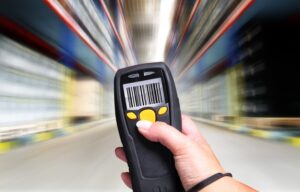Four Types of Barcode Scanners

Four Types of Barcode Scanners
Barcode scanners can be very simple devices. They read printed barcodes and output them to a computer. It is similar to a flatbed scan, consisting of a source of light, a lens, and a sensor that converts optical signals into electrical signals. Nearly all barcode scanners contain decoder circuitry that analyzes the image data of the barcode provided by the sensor, and sends the barcode content to the scanner’s output port.
On the market, there are four different types of barcode readers. Each barcode scanner uses a slightly varying technology to decode and read the barcode.
There are several types of readers: CCD, laser scanners, camera-based and pen readers.
CCD Readers
The CCD (Charge Coupled Devices) reader uses an array of hundreds tiny light sensors arranged in a line at the head of it. Each sensor is a photo diode which measures the intensity in the light directly in front of it. The CCD reader has hundreds of tiny light sensors that are arranged in a line. By measuring the voltages at each sensor, the reader can generate a pattern similar to a barcode. The main difference between a laser or pen scanner and a CCD scanner is that laser or pen scanners measure reflected light at a certain frequency from the scanner.
Pen Type Readers
The tip of the pen or wand contains a light source, and a small photo diode. You drag the tip across the barcode in an even, steady motion. The photo diode generates a waveform by measuring the intensity of light reflected from the source of light. This is then used to determine the width of the bars and space in the barcode. The photo diode generates a voltage waveform that is an exact replica of the barcode pattern. This is because dark bars absorb light, and white spaces reflect it. The scanner decodes this waveform in a similar way to how Morse code dots or dashes are encoded.
Laser Scanners
Laser scanners are similar to pen-type readers, except they use a light source called a laser. They also typically use either a rotating prism or a reciprocating lens to move the laser beam across the barcode. A photo diode measures the intensity of light reflected from the barcode, just like the pen type reader. Both pen readers and scanners emit light at a certain frequency. The photo diode detects only that frequency.
Laser scanners and pen-type readers can both be made with a variety of resolutions that allow them to read barcodes in different sizes. The size of a dot of light emitted from the reader is used to measure the resolution of the scanner.
Camera-based Readers
Camera-based barcode readers are the fourth type currently available. They use a small camera to take an image of the barcode. The reader uses advanced digital image processing to decode barcodes. Video cameras also use CCD technology, but instead of a single sensor row, they have hundreds of sensors in a two-dimensional arrangement.
A barcode is readable if the print contrast between light and dark bars is adequate and if all dimensions of the bar and the space are within the tolerances set for the symbology. A barcode should also have sharp edges, no voids or spots, a smooth surface, and a clear margin or “quiet zone” at each end.
Each barcode scanner design will require a specific type of precision lens. Our dedicated engineers and manufacturing facility will create the lens required for your scanner.
The barcode scanning technology has spread to many areas. The technology is everywhere, from the convenience store to the production line. The barcode scanner transmits the information to a computer. This allows for accurate and instant information to be output.




